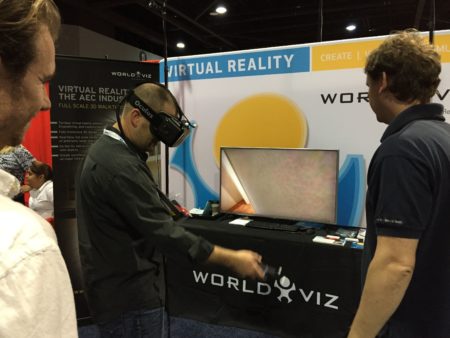We have heard conflicting reports about Apple and VR (virtual reality) initiatives. On the one hand, the Cupertino company has submitted and acquired VR patents and some VR software developers we know have pointed out that Apple may actually be working on a VR headset of their own. The word “may” is the operative word. As usual, we don’t really know for sure what Apple has planned.
“May” is Not Good Enough
While Apple may in fact be working on its own Apple branded VR headset, in the present time both consumer and pro-oriented users are focused on the dominant VR gear under development, chief among those being the famous Oculus Rift.
It was back in August of 2014 that AppleInsider wrote a report that Oculus VR was adding support for Mac OS X to the virtual reality SDK (software development kit). In the spring of this year Architosh experienced the Oculus Rift VR headset first-hand at the Vectorworks Design Summit and then again at the AIA National Convention and Exhibition, (see, Architosh: “AIA: Looking at the VR (virtual reality) craze in Atlanta,” 25 May 2015). But even then the question of Mac support wasn’t a done deal.

01 – Senior Associate Editor, Pete Evans trying on and exploring the Oculus Rift at the InsiteVR booth at AIA National 2015.
It turns out that the MacBooks Apple is shipping do not have powerful enough hardware (specifically GPUs) and that Oculus VR has made the decision to focus on just Windows for the initial launch of its hardware and software VR system.
So What Does It Take?
Usually, when developers don’t support something on the Mac the issue is software-related, like there is a missing native OS X software library, for example. Not this time. This time it is actually the Mac hardware that doesn’t pass muster. In truth though, a lot of Windows laptops (and desktops) will not meet the requirements as well, many in fact.
The chief component that Oculus VR needs is that computers have a GPU like the Nvidia GTX 970 or AMD 290 or higher. These are desktop -class GPUs and only the Mac Pro (the nMP) has the horsepower to support the Oculus Rift headset.
In a report filed after the 2015 E3 gaming convention, Oculus CEO Palmer Luckey noted that the current GPUs offered by Apple aren’t even close to meeting the spec, stating: “It’s not going to work on any Macbook that exists or is known to exist in the near future,” Luckey told vg247.com
Mac Developers Affected
This reality even affects developers currently working on and primarily loyal to the Mac.
“We’re disappointed that we can’t continue to develop VR for Apple computers at Iris; most of the team uses Macs as their primary development machines, and the very first prototype of the IrisVR software was written on a Mac over a year ago,” writes an un-credited author from professional VR developer IrisVR, on their company blog, explaining the Oculus Mac situation.
This is hugely disappointing news for Mac users at both the consumer and professional user level. Here at Architosh we have made big noise about the importance of VR in the architecture market; VR was all the rage at the National AIA Convention and Exhibition back in the late spring, which was keynoted by President Bill Clinton. While Bill’s talk was one of the stand-out moments at the US’s largest show devoted to the profession of architecture, the other was the sheer volume of VR developers exhibiting.
So yes, VR is hugely important to the AEC market, particularly at the design side with architects and engineers. And AR (augmented reality) is equally important at the construction and operations side. And to restate what should now be obvious to many in the AEC markets, Apple’s Macs have been gaining ground big time in the architectural industry in particular, so this is bad news to hear of such a setback pertaining to a technology so vitally key to emerging cutting edge workflows.
It will take Apple releasing its own VR headset and having developers at the ready to pounce on it in order to make up quickly for this setback.
Closing Thoughts
As a very smart colleague of mine recently pointed out, “Apple’s management has a growth mandate; growth at its current size will only come from mass markets.” Is the VR segment of gaming on the Mac a mass market? Heck no! No market segment on the Mac is a “mass market, including the Pro side of the Mac market. Only the Mac market overall is a mass market to Apple.
This is why, despite all the positive news about IBM’s Mac program and the fact that the Mac OS X platform continues to outgrow the Windows PC market every quarter, we are likely seeing the poor attention Apple is giving to the new Mac Pro and Pro markets in general.
But it doesn’t have to be this way. It doesn’t have to be two steps forward, one step back.
What Apple simply needs is just one qualified person (the right person!) who understands each Pro market so well, that they can make sure that Apple’s hardware and software strategies are in acceptable alignment with meeting the long-term directions of each pro market.
That way, those developers at IrisVR, who love coding on their MacBooks, don’t have to move off of them while at the same time Apple is touting gains that IBMers are ditching their Lenovo machines for Macs!
Is this really that hard to ask of Apple?
Other VR Related Articles at Architosh
MORE: AIA: Looking at the VR (virtual reality) craze in Atlanta




Reader Comments
Comments for this story are closed